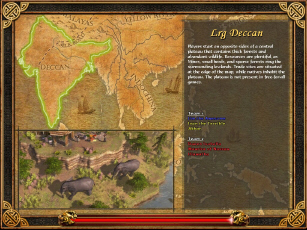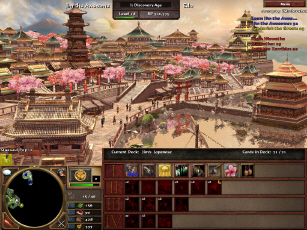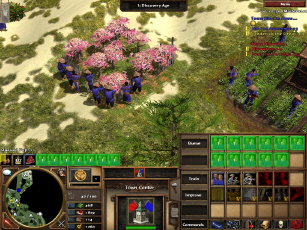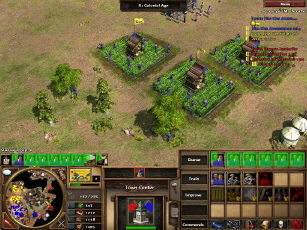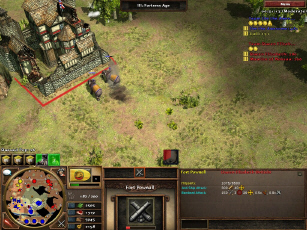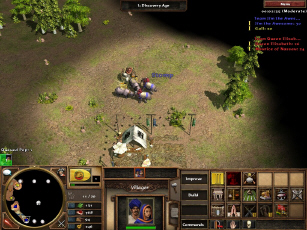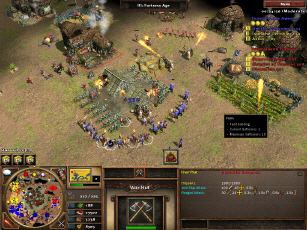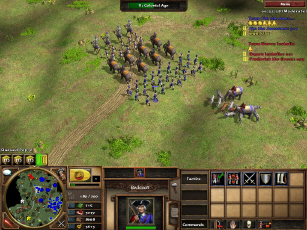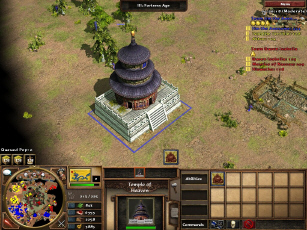|
|
||||||||
THREE DRAGONS THE ASIAN DYNASTIES EXPANSION FOR MICROSOFT'S AGE OF EMPIRES III
Age of Empires III followed the usual pattern with real time strategy games. First there was Age of Empires III in 2005, and then came the inevitable expansion in 2006, The War Chiefs, which completed the game. What is unusual in the RTS world is that the developers kept right on going, recently releasing a second expansion kit. The Asian Dynasties expands Age of Empires III from its New World theater of operations back to the Old World, adding three Asian powers and the maps to fight over most of the Asian continent. There are three new powers, representing China, Japan and India, and numerous indigenous non-player Asian groups that can be made allies similar to the Native Americans introduced in The War Chiefs. The Asian Dynasties does more than add three more sides to the original game, with a few new units. Instead, it presents entirely different ways of doing things. The first difference is that Asian powers collect resources through new assets. All can build the rice patty, which functions as a combination of the original installment's farm and plantation. By default, up to ten civilians working on a rice patty collect food. However, at the player's discretion, any rice patty's production can be switched over to coin, working as a cash farm in the same way as a European plantation. Home cities can also send special resource assets as part of their shipments to the player's "colonies." Japan has cherry orchards, where peasants collect food, and the Indians have mango groves, which are sources of wood. Eventually they become exhausted, collapsing in a cloud of smoke, but while they are on the map they are welcome sources of resources when the player needs them the most. They are particularly important in more arid environments, where berry bushes, wild game and forests may be in short supply. Cultural differences work their way into how colonies grow. For example, the Japanese, vegetarians throughout the Tokugawa era, do not hunt or raise animals for meat. The Indians do not use food to create civilians, only military units, paying the price in wood instead. This design decision seems like an arbitrary one, with the intent of making the Indians different. What is understandable is that Indians cannot harvest food from domesticated animals, but can raise them at sacred fields in exchange for experience points. Unlike the Japanese though, they can hunt for their food. Unlike the Europeans and American Indians, neither the Chinese nor Japanese support their population with houses. China has villages, the Japanese shrines, and each is a little different than houses as understood throughout the Age of Empires series. Japanese shrines yield limited quantities of the resource of the player's choice, and villages can be garrisoned against attack. One of the key innovations of Age of Empires III over its predecessors is the use of a named, task-specific explorers instead of fast, light military units, usually mounted, to scout the map from the beginning. Generally, a player receives one man, with an historical name. He usually has a special capability, such as being able to kill a treasure guardian with a single rifle shot. If he gets killed the player can pay a price to bring him back to life at the town center, so the character is functionally immortal as long as the player is willing to pay for his resurrection. Explorers in The Asian Dynasties have religious overtones, and with them capabilities that their European and Native American counterparts lack. Indian Brahmins ride elephants, which can stomp enemies in combat. The Chinese start with a Shaolin monk and one disciple, and the Japanese with a pair of Ikko-Ikki monks. All having healing powers, either from the beginning or through upgrade, in addition to the explorers' standard capabilities of building trading posts and, eventually, town centers. The expansion calls back to Age of Empires and Age of Empires II in its approach to fortifications. In Age of Empires III, a player could build two general types of fortifications, in addition to cheap, passive stretches of wall. Outposts are tower-like works that can be built in quantity, and upgraded as the player advances through the ages. Forts, in Age of Empires III, arrive as shipments from the home country, and are much stronger, with unit construction capabilities similar to castles in the Age of Empires II. They have a fresh disadvantage though in that only one is usually available to each player, and once a fort is destroyed, the chances of getting another one are usually zero. Castles make a reappearance in The Asian Dynasties. They can be built earlier in the game than those in the earlier title, and in practice are weaker. Also, they are where artillery and siege units are raised, giving them special value as production centers. Staples of earlier Age of Empires games, until now wonders have not been part of Age of Empires III. They are the second type of buildings brought back through The Asian Dynasties, again a little different than before. In the earlier games, a player can construct one wonder, and win the game if it lasts long enough. Additionally, normally that is the only benefit that it has, other than being an impressive cultural ornament. In The Asian Dynasties, wonders return to a greater functionality that they have in the series' cousin, The Rise of Nations. In the newer game, wonders enhance capabilities. In addition, an Asian civilization advances to the next age through the construction of a wonder, and by no other means. Europeans and Native Americans still do so by spending the required resources at a town center, and get nothing out of the effort except the right to go the next stage of history. Asians get the benefits of the wonder, and since it is constructed independently of what happens at a town center, the latter building can continue producing population while one of the existing peasant units attends to societal advancement. By both freeing town centers of the task of pressing to the next age, and giving the civilization a special capability, The Asian Dynasties gives its new peoples important advantages, if the player knows what to do with them. The combat units available to all three new civilizations are are consistent with the image at least of the controlling countries, though showing some incursion into fantasyland. For example, the first siege unit that China receives is a giant flamethrower, and India's chief weapon against buildings a big mean elephant that throws its trunk around savagely. In China, military units are not raised one by one, breaking a norm that extends from the Age of Empires franchise across the RTS genre. The Chinese player raises them as combined arms armies, with the mix of units depending on the type of enemy for which he sees the greatest need. A new building supplies the European-style units that Asian powers lack in The Asian Dynasties: The foreign consulate. It relies on a new type of resource peculiar to Asian sides, exports, and offers a new level of decision-making that European and Native American sides lack. An Asian player can actually raise European forces at a consulate, expending exports to do so. They enter in groups, similar to Chinese armies, and with similar burden to population limits. One new decision that a player has to make is whether to run his economy in order to generate more exports. This enables him to call upon more European troops, but in exchange he accumulates other resources, the ones used for domestic purposes, at a slower rate. If he wants masses of European troops fighting his battles, then exports are the way to go; if he wants more native units, with the foreigners playing a secondary role, then he should leave the balance at its default level. The Japanese has another option, which is for isolationism. The benefit is that instead of receiving allies from Europe, he can build specialized Japanese units at his consulate. If The Asian Dynasties was going to be strictly about Asian civilizations competing with each other, then it probably would have been published as a stand-alone game. However, as it is intended to be played with Age of Empires III and The War Chiefs, there has to be a way of reconciling the very different building and production schemes with the other titles. The way to do that is that every side plays by the rules of the installment that introduced it. If Europeans from Age of Empires III are fighting against or alongside Asians from The Asian Dynasties, they function as though the latter expansion was not even there. They do not collect or spend export resources, and have no access to the units and buildings that define the new powers. The same goes for American Indians introduced in The War Chiefs. Therefore The Asian Dynasties can be played in combination either with Age of Empires III alone, or with the other expansion. Age of Empires III is a prerequisite for playing The Asian Dynasties, but in its relationship with The War Chiefs, they can be viewed in a way as expansions to expansions. Nonetheless, even if no Asiatic sides are going to be in play, The Asian Dynasties can still benefit the others by providing the new maps. The maps take a slightly different approach than in the earlier installments. In most if not all, a player starts near at least one treasure that, if he has even a modicum of skill, he should be able liberate immediately with his religious scouts. He might have to use their special capabilities, such as stunning two out of three guardians so he can beat up on them in detail, but providing a clinic in their proper employment might well be the entire point of the treasures' placement. There are several variations on the general Silk Road theme. On these maps, there are trading posts already in existence along the legendary trade route, in the hands of neutral guardians, identical to treasures. The player gains possession of a trading post by going there and killing the guardians. He has to guard it himself then, as if a foe passes through and there is no opposition, it goes over to that enemy side. Playing on the Silk Road requires The Asian Dynasties, but not necessarily Asians. There are fun possibilities of pitting Europeans and Native Americans against each other for control of a place native to neither. There are problems with The Asian Dynasties, and they are the same those in the earlier installments, and to even to the entire Age of Empires family. Specific to Age of Empires III, the animation is slow and jerky, even all other applications shut down. The desktop system on which I tested it exceeds the game's requirements in every way, including having 128 megabytes of video memory on an NVIDIA GeForce FX 5200, whereas The Asian Dynasties calls for 64 megabytes. My computer also has a full gigabyte of random access memory, four times what the game nominally requires. Still, the animations remain rough, and selecting groups of units a chore. Artificial intelligence has long been something of an issue in the series. Either the computer-controlled powers are idiotic pushovers, or overly tough. Finding the sweet spot between them can be a real challenge. Age of Empires III and The War Chiefs were improvements over Age of Empires II in this regard, with some challenging games possible against a computer opponent in the middle of the difficulty scale. Sometimes in those games one finds a computer opponent that is aggressive without being suicidal, and might even surprise a human player. The Asian Dynasties, unfortunately, takes a step backward. Even with the artificial intelligence set on Moderate, computerized opponents play amount to excessively easy, even stupid, opponents. They lack both skill and aggressiveness, and when a human attacks their settlements in force, the settlement is usually doomed. Another problem surfaces if a computer-controlled army attacks one of the player's assets while the human is busy destroying that side's towns. The software does not respond, continuing the offensive, even if it doomed or against secondary objectives, while the home base is reduced to ashes. It would have been far better if the artificial intelligence had some chance of responding to make an effective counterattack, or calling the army home to fight the really decisive battle. Computer-controlled allies are some of the worst-commanded parties in any computer wargame. They are singularly unaggressive, some of the most passive in the series, and in some test games they surrendered with shockingly little reason. Sometimes their main contribution to the player's efforts is simply by not being an enemy. Ideally, the Age of Empires III development team will address these problems with future patches and updates. The Asian Dynasties is a good addition to the Age of Empires III system, and will be embraced by enthusiasts of the game. One cannot deny that it is truly a major supplement to the core title, and not just a set of new civilizations under new names, and with a few new units included to make it look good. If The Asian Dynasties was released as the core of a new Age of Empires subseries, it would still have been a worthy addition, due to the different approaches needed to for non-Western, non-Native American cultures. Besides augmenting Age of Empires III with Asian-oriented maps, it finally gives nod to one of the most fascinating theories of pre-Columbian America. Ever since reading Gavin Menzie's excellent book 1421 early in 2007, I wanted to see the Chinese added to Age of Empires III. Menzies makes a very good case that Chinese treasure fleets explored the world, or all of it except Europe, seventy years before Columbus set sail. In fact, he postulates that Columbus' certainty that a westward voyage to reach the Indies was based on Chinese data that had reached Europe through the court of Prince Henry the Navigator of Portugal. A retired Royal Navy submarine captain, Menzies makes a very good case, from the perspective of an expert navigator. Whether or not one fully accepts Menzies' assertions, and many though not all are compelling, they are good material for a game. The Asian Dynasties finally gives them due attention. With its publication, Age of Empires III finally crosses the hemispheres, to the places where Columbus wanted to go all along. For all of the technical frustrations with The Asian Dynasties, the conceptual elements make it a fine addition to the series.
|

